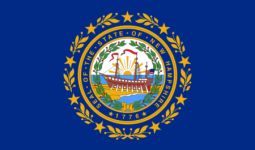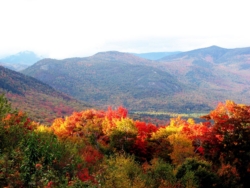New Hampshire
New Hampshire is a state in the New England region of the northeastern United States of America. It is bordered by Massachusetts to the south, Vermont to the west, Maine and the Atlantic Ocean to the east, and Canada to the north.
- ABBREVIATION: NH
- NICKNAME: The Granite State
- POPULATION: 1,323,459 (2013 est.)
- CAPITAL: Concord
- STATE BIRD: Purple Finch
- STATE FLOWER: Purple lilac
- AREA: 9,304 sq. mi.
- TIME ZONE: Eastern
- ENTERED UNION: June 21, 1788
- ALTITUDE: High, 6,288 ft. Mount Washington
- CLIMATE: Short mild summers, cold winters; moderate rainfall, heavy mountain snows.


Inspired by New Hampshire’s granite-ribbed ridges, Nathaniel Hawthorne once wrote: “Mountains are earth’s un-decaying monuments.” But his poetic line overlooks the fact that the state’s mountains, middle-aged by the timetable of geography, have been decaying for eons. Once rising in sharply pointed towers like today’s relatively young Rockies, they have been ground down by glaciation and erosion to their present rounded shapes. But monumental they are none the less. The sculptured white mountains, pierced by sheer gorges like Franconia and Crawford Notches, dominate the whole of New England and also play an important role in New Hampshire’s economy. New Hampshire’s scenic and recreational resources, tourism now brings over $3.5 billion into the state annually.
Although New Hampshire has many dairy and produce farms-most of them in the fertile valleys south of the mountains-manufacturing provides a sizeable chuck of the state’s income. Fast falling rivers, notably the Connecticut and the Merrimack, supply hydroelectric power for major industries, notably computer and electronic products.

New Hampshire’s pine and hemlock forests, cut in the 18th Century to supply masts for the British Navy and logged off by the pulp industry in the 20th Century, have grown back with the application of modern forestry techniques. The state’s trees have not only been conserved for use by industry but also for their sheer beauty. Federal Wilderness Areas exist within New Hampshire’s White Mountains National Forest. Almost 150,000 acres are protected in 6 designated areas. These areas are protected from logging and commercial industries and are used solely for recreational and scientific purposes.
FUN FACTS:
- In 1963 New Hampshire became the first U.S. state to adopt a legal lottery in the 20th century. Since it started, the lottery has raised more than a billion dollars to aid education.
- New Hampshire was named by Captain John Mason after his home county of Hampshire in England.
- The famous naturally carved granite profile known as The Old Man of the Mountain in Franconia Notch State Park was destroyed by a rock slide in 2003. For centuries it served as a rugged symbol of the state.
- The first strike organized by women workers in the United States occurred in December 1828. Several hundred workers walked out of the Dover Cotton Factory to protest new management policies that forbid them to talk on the job, reduced wages from 58 cents a day to 53 cents a day, and docked them a fourth of a day’s wage if they arrived after the morning bell stopped ringing.
- The first public library in the United States was founded in 1833 in Peterborough, New Hampshire.
- The first private citizen in space was Christa McAuliffe, a school teacher from Concord, New Hampshire. After her death in the Challenger Space Shuttle disaster in 1986, a planetarium/discovery center was built in her honor in Concord.
